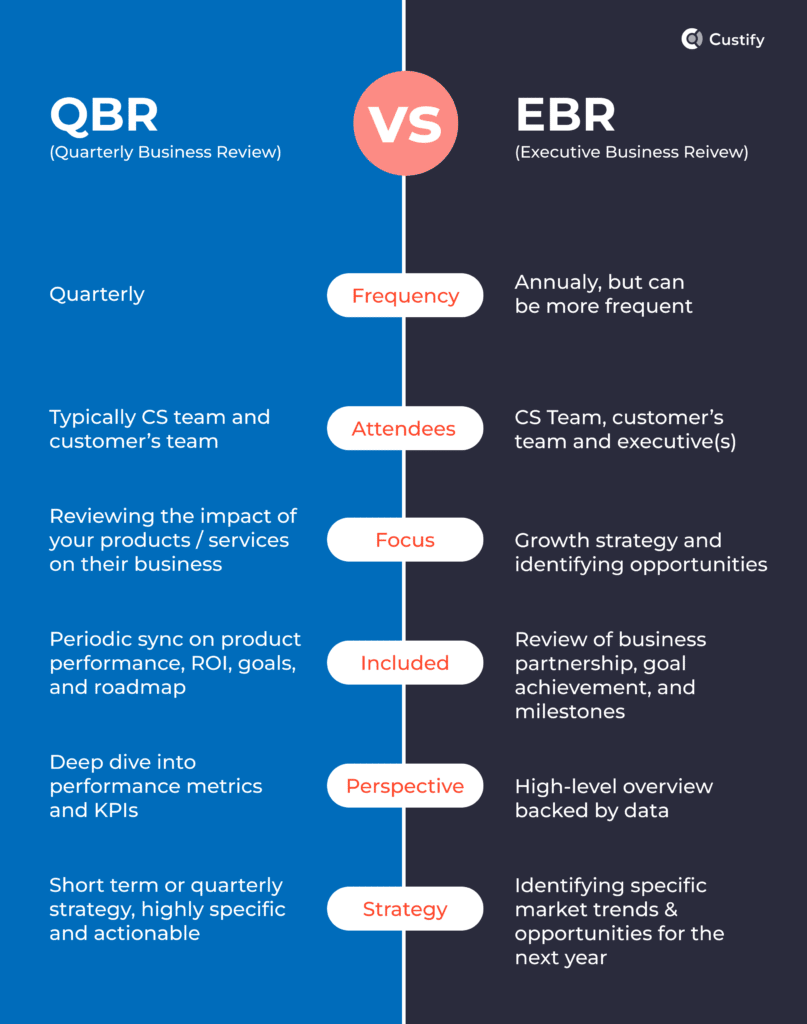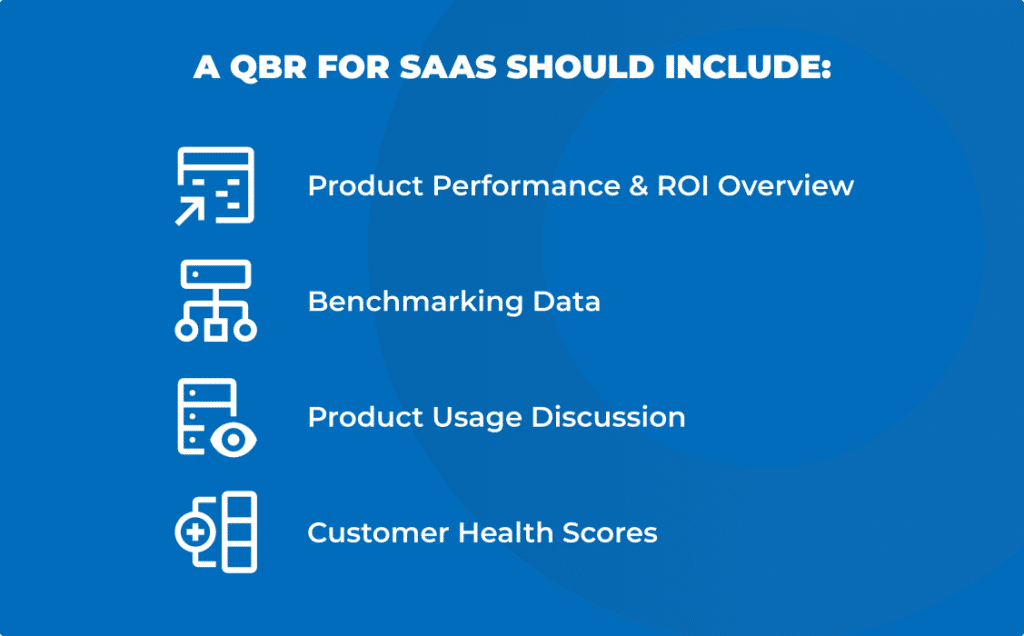As a SaaS business, one of the best ways to ensure continual growth with your customers is to form long-term partnerships by holding quarterly business reviews with them. But opinions about quarterly business reviews tend to be divided: some believe they’re essential, others just believe they’re nice to have.
One thing that’s certain is that quarterly business reviews help in reminding your customer why your products or services add value to their business.
And the key to delivering successful reviews is knowing your customer very well and adjusting based on their specific requirements, to assist them in achieving their business goals – and that’s where Customer Success plays a great role. These meetings can be crucial to the overall health and success of your customers.
Read along to make sure you master quarterly business reviews for your SaaS.
What Is a QBR (Quarterly Business Review)?
What QBRs ARE:
QBR is an acronym for Quarterly Business Review, and, as its name states, it’s a meeting with your client, which you run on a quarterly basis, with the main objective of going through and reviewing the impact of your products or services on their business.
QBRs help you scale your SaaS growth, discuss future goals, and help you know how to add more value for your customers. This forms an important aspect of any CSM’s role in driving success for all clients.

What QBRs AREN’T:
- A sales pitch
- A friendly encounter
- A session of boasting (although you should still emphasize your wins)
It’s essential to understand that QBRs are great only when they match the goal of customer success as a whole: to help customers. Self-serving quarterly business reviews will only alienate your customers and make them reconsider whether you’re actually serving their interests or just a grifter trying to get their money.
QBRs should be focused entirely on your customer, and whether or not your products and services help them reach their business goals.
What’s the PURPOSE of a QBR:
The main purpose of QBRs is to help you understand the desired outcomes of customers’ business and deliver tailored recommendations.
If implemented correctly, it can promote loyalty and ensure a seamless renewal process – which is what you want for your SaaS business.
CSMs can therefore dive deeper into acquiring a more insightful view of their customers’ business goals for future strategies and assist them to achieve their objectives.
Who’s INVOLVED in a QBR:
QBRs truly serve their purpose when executive-level individuals from both your company and your customer are present during the meeting – turning it into an EQBR, or a quarterly EBR (executive business review). This way, both sides will be able to assess correctly how they fit into each other’s plans and objectives.

However, as you scale your growth with your own SaaS business, keep in mind that you will most probably become unable to host QBRs with every single one of your customers.
As a rule of thumb, it’s better to focus on running QBR sessions with your top accounts – and that’s where customer segmentation comes into play.
You will most likely run QBRs just for your best-fit, largest, or most relevant accounts, the top segment of your customer base because they’re the ones who require (and also deserve) your company’s undivided attention. Prioritizing these customers during your QBRs will drive word-of-mouth references, increase your referrals, and increase your prospects for growth.
Should My Business CARE about QBRs?
There are several practical benefits to running QBRs from a SaaS business POV:
- QBRs strengthen the relationship between you and your customers and keep you connected.
- QBRs help to identify and analyze business challenges, assess their impact, and come up with personalized solutions.
- They provide the perfect setting to reinforce the value of your products or services to the customer, by highlighting the overall ROI.
- QBRs allow for honest discussions about your customers’ health and what you can do to improve their health scores.
- By giving you the chance to highlight your input in driving success for your customer’s business, QBRs should leave no doubt about renewals. It’s a win-win situation.
Should Customer Success CARE about QBRs?
From a CS POV, there’s a larger discussion about QBRs and their place in a customer success strategy.
Customer Success is just as much about building relationships as it is about the value of your actual product or service. Without regular meetings with your customers (virtual or face-to-face), you risk being out of touch, which can lead to a range of issues from poor communication, increased friction, problems using new features, and eventually, to churn.
That’s why QBRs are frequently seen as the perfect occasion to build upon your partnership with your customers. They provide the perfect platform to identify what’s working, what’s not working and to map out future strategies for driving further success for your SaaS and your customers.
But that’s something not all CS professionals agree upon.
Some consider QBRs to be redundant and unnecessary, when your CSMs already interact with your customers on a regular basis, in an appropriate manner, tailored to the needs and goals of that particular account.
Obviously, there’s no doubt that QBRs provide a lot of value, as long as they’re done correctly and with a clear goal in mind.
But if they are merely another chat with one of your customers, asking them how they’ve been doing, then it will easily turn into a waste of your time and theirs. So how do you make sure that doesn’t happen with you? Let’s find out.
QBRs for SaaS: What Should You Include?
1. Sketch Out A Discussion Agenda
In order to prevent the meeting from derailing, with side questions or other concerns, it’s best to create a QBR agenda and also to deliver it to all attending parties way ahead of time.
Content collaboration tools are essential for ensuring that all stakeholders can contribute effectively to the QBR process.

2. Emphasize On Product Performance & ROI
Make sure to emphasize Return on Investment (ROI) and present key data points and results that demonstrate the value you have delivered for that customer in that time period.
In theory, if your customers are on annual contracts, you should have 4 performance reports to show them their ROI. This, in turn, will make the renewal process a breeze, because you’re showing them the value your product or service brings. Here’s a small ROI calculator we built to show our customers the value of using Custify – with just a few data sets, you can create a full set of numbers to showcase how you’ll help customers.
Optimized data sets are the cornerstone of any QBR, so before you set up your first QBR, make sure to practice good data hygiene. This ensures you present numbers that truly matter and provide insights into the success of your customers. Check out some more actionable points on data hygiene from Philipp’s chat with Andrew Michael of CHURN.FM:
3. Include Benchmarking Data
Your customers will be considerably more willing to conduct further business with you if you can link their success to your product using these key metrics.
Think about how your customer compares to others. Use these SaaS-specific metrics to identify where they might be falling short and what needs to be done in order to get them up to, or past, the industry benchmark.
4. Highlight Product Usage
Using project management collaboration tools can streamline your QBR preparation and ensure all team members are on the same page. Discussing how your customer is using your product should become a standard part of your QBRs. Include reviews about:
- Which product features are being used, which aren’t.
- Who are their most active users.
- How their product usage compares over time & usage trends.
- Overall value received.
5. Provide Insightful Data In The Form Of Health Scorecards
Customer Health Scores highlight how much value you are providing to your customer, as well as how much value they are providing back to you.
Regularly monitoring Customer Health Scores will help you avoid customer churn in the long run, by identifying opportunities and risks early on. Make sure to include data about:
- Overall Account Health Score,
- Goal-aligned KPIs, Metrics, and Results,
- Health Score Trends.
Customer Health: Where Customer Success Meets QBRs
Customer health is a very important part of QBRs. And Customer Success can help by providing the necessary data to accurately report on customer health, for successful QBRs with your top customers.
By regularly monitoring Customer Health Scores, early signs of increased friction or declining customer engagement become easier to identify.
But before you start calculating you’ll need to define certain metric categories for your Health Scores. Health Scores differ greatly by industry, and how you calculate them for your clients is determined by the indicators that are most significant to your company.
By tracking your Customer Health Score using a Customer Success software such as Custify, you will be able to:
- See which most or least used features lead to churn.
- Figure out patterns in user actions that lead to customer goal-achievement and higher ROI.
- Identify customer success KPIs that you’re not meeting so you can adapt your product to better suit your customers’ needs.
Not only will Customer Health Scores help you gain a better grip on your customer’s behavior and usage of your SaaS product or service, but they will also help you greatly in conducting your QBRs.
Learn everything there is to know about Customer Health Scores in our guide.
Summing Up: What Do QBRs Mean for CSMs?
QBRs and EBRs might not be essential for every business – and the decision should ultimately be left to CS. Then if you decide to go forward with them, it’s essential to make sure you conduct them properly.
All in all, they provide a great opportunity to strengthen your relationship with your customers. Not only do QBRs enhance your partnership with your customers, but they will also help you reinforce the ROI of your product with each of your customers, further delivering success.
QBRs are sure to become your CSMs’ favorite tool to engage executives from both sides while enabling healthy conversations around your assessment of each customer’s overall health.
Want to find out more? Reach out to us and let us help you out.




